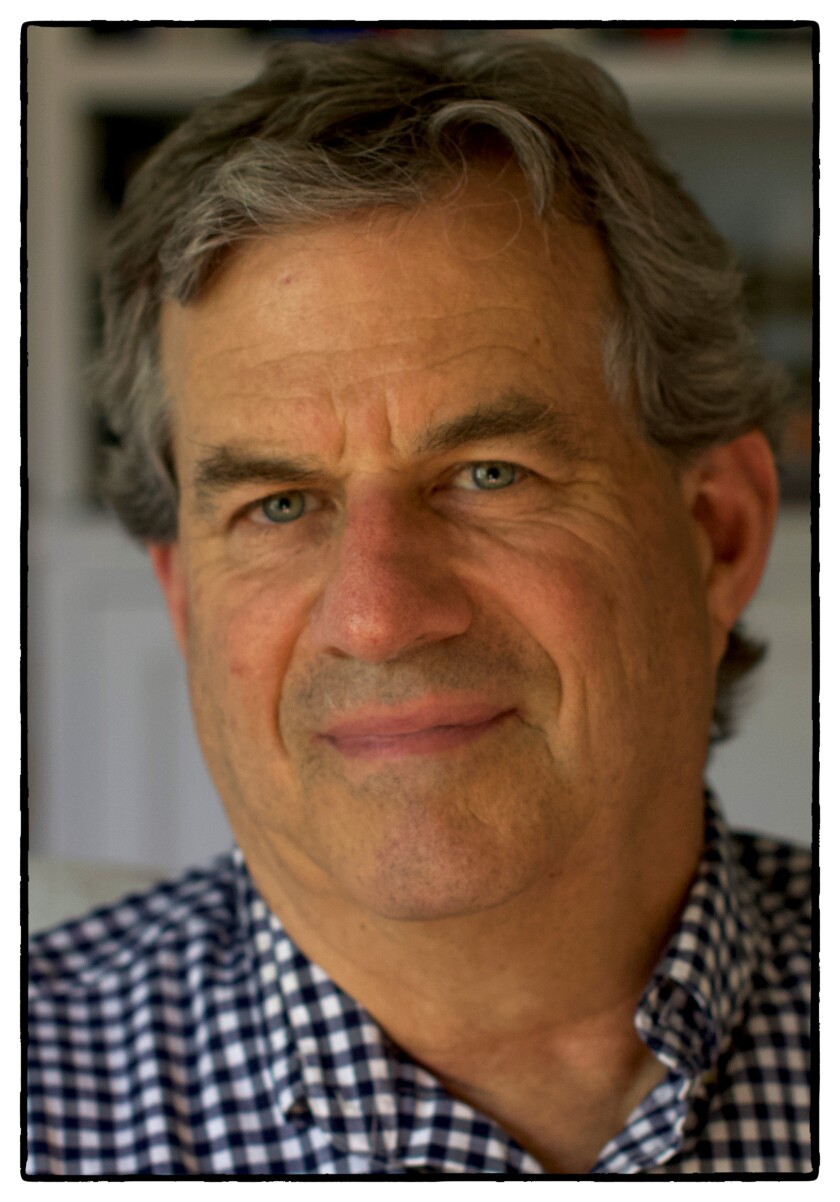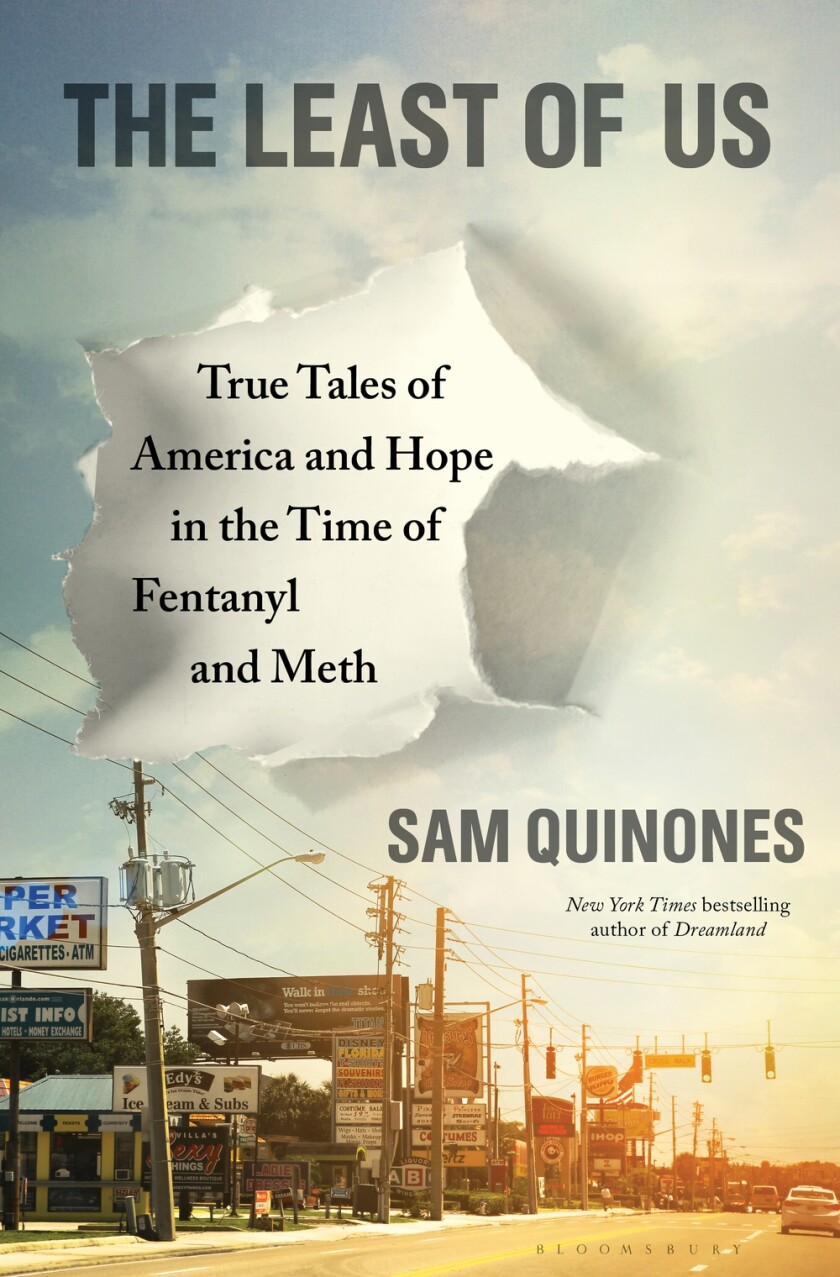On the Shelf
The Least of Us: True Tales of America and Hope in the Time of Fentanyl and Meth
By Sam Quinones
Bloomsbury: 432 pages, $28
If you buy books linked on our site, The Times may earn a commission from Bookshop.org, whose fees support independent bookstores.
When journalist Sam Quinones went looking for a buyer for the book that became “Dreamland” a decade ago, there was little interest. Only one publisher was interested in the story of an Ohio everytown savaged first by painkiller-pushing Purdue Pharma and then by Mexican black-tar heroin cartels.
“Nobody really knew what an opioid was,” recalled Quinones, who at the time was a Los Angeles Times staff writer.
The 2015 book became a commercial and critical hit, winning a National Book Critics Circle award. Others followed with works about the opioid epidemic, including Beth Macy’s “Dopesick,” now a Hulu series, and Patrick Radden Keefe’s “Empire of Pain,” about Purdue’s owners, the Sackler family. The company eventually crumbled into bankruptcy under the weight of thousands of lawsuits.
Quinones’ latest book, “The Least of Us: True Tales of America and Hope in the Time of Fentanyl and Meth,” is — despite its somewhat upbeat subtitle — an equally distressing read. Mexican drug traffickers have figured out how to make more damaging drugs more cheaply, effectively controlling the lives of addicts and communities across the U.S.
Quinones cuts the baleful trafficking news with stories about innovative rehab programs, drug courts and addicts who get clean. But these wins look paltry in comparison with the traffickers, who count their victories by the ton or in the hundreds of millions of dollars.
One of Quinones’ subjects, a longtime addict in Kenton, Ohio, kicks heroin and gets a job as a 911 operator. It’s “a good story” for the book, he acknowledges. When the man relapses, he seems to beg the reader not to lose hope: “It’s not a Hollywood movie. It’s life and it’s hard.”
Quinones spoke to The Times last week from Nashville, where he now lives, about the current state of addiction, how a new type of meth may explain L.A.’s homeless problem and why he remains hopeful. The conversation has been edited.

A heroin user displays a needle in a South Bronx neighborhood with the highest rate of heroin-involved overdose deaths in the city on Oct. 6, 2017.
(Spencer Platt / Getty Images)
When you finished “Dreamland,” did you think you would write another drug book?
No, because I was still thinking old school, and I thought what could possibly be worse [than heroin]? I also didn’t think anyone would read [“Dreamland”]. I had a terrible, terrible time finding people … who wanted to talk about it. And so I just thought to myself, nobody’s really interested in it. Then what happened was the book really helped ignite a lot of awareness. More and more people were feeling the courage to come out of the shadows. I saw fentanyl taking hold. I saw the meth problem getting very sinister. So all of that made me feel like this was kind of a new era.
The general public didn’t really get the opioid epidemic when “Dreamland” came out. Now, after “Dopesick” and “Empire of Pain,” the Sacklers are public enemies. You might feel a sense of vindication.
I remember touring this very, very impoverished neighborhood in southern Ohio, where OxyContin addiction was just rampant. It was just horrible what it had done to that little place. These are people who are already living in trailers. And I remember thinking to myself, there is no way this company so powerful, so monied and so removed, is ever going to be called to account for this.
By the time I turned in the manuscript, there were three lawsuits against these drug companies. Now there’s — I can’t remember — 2,600, 3,000. I have spent the last five years just stunned at what has happened.
As this new book makes clear, the drugs in your first book are ancient history now. They’re like drug world landlines: Nobody uses them anymore.
We awakened this very sophisticated giant of an underworld industry in Mexico to this new consumer base that we had created with the opioid epidemic. Fentanyl is in every way superior [to heroin] if you’re a trafficker. No more need for land, growing seasons, farmers, harvesting. You only care about shipping ports.

Sam Quinones has a new book, “The Least of Us,” that blames a new brand of meth for the rise in homelessness and mental illness.
(Caroline Quinones)
Conventional wisdom is that if the demand in the United States stopped, Mexican trafficking would end. You say no.
Yeah, the suppliers are running the show now. They have so inundated the country, from Vermont to L.A., with this very potent, extraordinarily cheap methamphetamine. Now you’re finding people who were addicted to opioids [who] have switched to meth. The trafficking world perceived that there was this new massive consumer base of drug users that would buy whatever was cheap, potent and relentless. So they have changed demand with supply.
You theorize that the homeless explosion in L.A. can be traced to a change in the formulation of methamphetamine in Mexico 15 years ago. I hadn’t heard that before.
I believe that’s most definitely what’s happened. In 2008, the Mexican government decided to make ephedrine [a stimulant long used in making meth] effectively illegal. And the trafficking world had to switch to another form [known as the P2P method]. By 2012, 2013, tests [on seized meth] from the DEA [Drug Enforcement Administration] showed that it was all being made with P2P.
What only now is becoming clear is that P2P meth carries with it profound symptoms of schizophrenia, primarily paranoia and hallucinations. The ephedrine meth was a party drug, big in the gay community. Kind of a euphoric thing. But now this meth puts people into their own brains. There’s not a lot of that wanting to be with other folks.
So when you’re driving through L.A. and see people who are naked, people crawling on the ground, what you see is P2P meth?
Yes. Also when I see big stacks of bicycle frames, shopping carts. This stuff seems to breed hoarding in a spectacular way. It seems to turn people mad and incapable of living with other people, very quickly.

This is not what I would call an optimistic book, yet the subtitle refers to hope. Were you concerned that people wouldn’t want to buy more bad news?
It’s a complicated answer. I have been a journalist for 34 years, and yet I’m not cynical. I began to believe, as I worked in all this, that what really had gotten us into a lot of this problem was that we wanted big, sexy, magic bullet answers to very complicated problems. That seems to be a damaging narcotic in itself, and creates all kinds of unintended consequences.
The real way to foster change is to work in small ways, small steps, not looking for credit. I set out to find the smallest, least noticed, least sexy stories of Americans involved in community repair that I could find. That became as much or more important to me than this very sinister story about methamphetamine and fentanyl.
You had a heart attack while writing this book and were treated, ironically, with fentanyl. Writing this kind of book would seem to be really stressful. Why do you do it?
Well, this is one of the great stories of our time. Very early on I thought I was writing about drugs and drug trafficking and drug marketing. And really, I was writing about America. This is all about who we are, what we have been, what we have become as a country. Also I would say, I’m interested in everything. Stories that fascinate me could be very grim [or] very hopeful. But they fascinate me equally. That’s why I became a journalist. That’s why it’s the best job in America.
Stay connected with us on social media platform for instant update click here to join our Twitter, & Facebook
We are now on Telegram. Click here to join our channel (@TechiUpdate) and stay updated with the latest Technology headlines.
For all the latest Entertainment News Click Here
For the latest news and updates, follow us on Google News.
